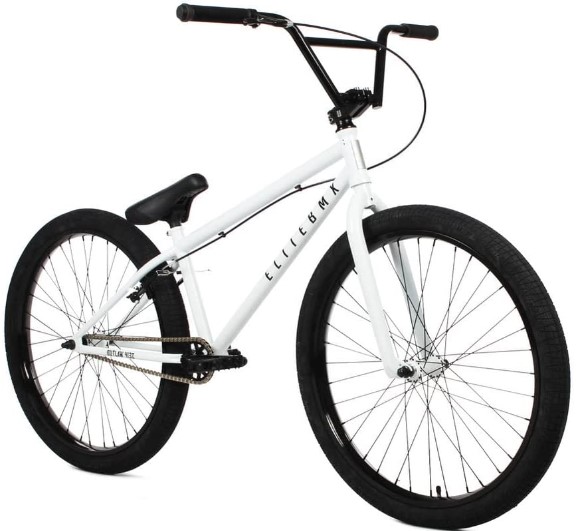One consideration when buying a new BMX bike, or any bicycle for that matter, is the frame. But do you often ask, ‘what are BMX frames made out of?’
Steel is the most used BMX bike frame as it’s cheap. But following its high weight, most frame manufacturers opt for aluminum for entry-level BMX bikes and carbon fiber for high-end BMX bikes, while a few top-end BMX bikes feature titanium.
But which material should you go for? I’ll discuss the four primary BMX frame materials, highlighting their pros and cons to help you make an easier decision.
How about if you are thinking of making your ‘custom’ BMX frame? Well, I will also give some insights on the steps to follow to do just that. And lastly, I’ll answer questions relating to BMX frame materials.
Let’s get started!

What Are BMX Frames Made Out of?
As shared earlier, BMX bike frames are made of these frame materials types:
- Steel
- Aluminum
- Carbon
- Titanium
Now, let’s discuss the different types of BMX frames:
1. Steel BMX Frames
For over 100 years, steel was the only material for making bike frames. However, in the mid-1990s, aluminum and chrome alloys came through.
Steel is acknowledged for its sturdiness and strength despite it being heavy. The material is also easy to repair. And unlike aluminum, steel can withstand harsh landing after a magical jump. On top, it doesn’t wear down quickly.
Due to all these impressive qualities, steel remains popular in the BMXing world. Sadly, the frames are prone to rust, thus needing coating or painting unless it’s stainless steel.
Generally, steel comes in 3 distinctive types that include:
- Carbon steel (high-tensile steel)
- Chromoly steel
- 1020 steel
Let’s discuss them below:
a) Carbon Steel
Commonly referred to as high-tensile steel, carbon steel features mostly in kids’ and entry-level BMX bikes. Pro BMX riders overlook this carbon steel frame because it’s heavy and thus not the best for stunts and midair jumps.
However, BMX bikes with these frames are stiffer, durable, and more robust, and you can trust them to last for a long time.
b) Chromoly Steel
Widely known as the 4230 metal, Chromoly steel is lighter than carbon steel and has a moderate strength-to-weight ratio.
Though Chromoly steel frames are lighter, they are responsive, and regardless of prolonged usage, they remain in their indestructible form.
c) 1020 Steel
1020 steel is another affordable steel grade common in some BMX bikes. These frames are popular among beginner BMX bikes and considered cheap.
Other BMX frames feature a combination of 1020 steel and Chromoly steel. Bikes with the two mixes are not only lighter but more durable.
Advantages of Steel BMX Frame
- Strong and durable
- Most affordable
- Readily available
- Easy to repair when damaged
- Comfortable
Disadvantages of Steel BMX Frame
- Heavier than the rest
- It makes the bike slower
2. Aluminum BMX Frames
You will likely find bikes with aluminum frames at mid-range and budget price points. These bikes are not just affordable, but they are also lightweight and stiff.
The form of aluminum in these cycles is alloy form. That means that aluminum is mixed with some elements to change its physical property because the pure aluminum is too soft to be molded into a bike frame.
You will likely find two dominant aluminum frames with codes 7005 and 6061. These alloys mean magnesium and silicon are added to the aluminum, thus making it more robust.
Though aluminum frames are light, they come second to carbon fiber. But do not get the impression that light is a weakness. In fact, they have a more excellent strength-to-weight ratio, making them stronger although lightweight.
However, even though aluminum frames are stiff, you are likely to encounter road buzz and thus not a good pick if you are looking for a racing BMX bike.
Again, aluminum frames are difficult to repair and usually fatigue quickly.
But since aluminum is readily available and more affordable, it’s popular among riders on a budget.
Advantages of Aluminum BMX Frame
- They are affordable
- They are readily available
- Have a good strength-to-weight ratio
- They are lightweight
- They are corrosion resistant
Cons of Aluminum BMX Frames
- Their stiffness can lead to poor ride quality
- Fatigues easily
- Difficult to repair after a crash
3. Carbon BMX Bike Frames
You will find carbon fiber frame material in high-end BMX bikes. A carbon fiber frame is made by embedding carbon sheets using resin.
Though bikes with these frame materials are expensive, they give you an aerodynamic performance. They are stiffer, more comfortable, and even lighter than aluminum, which explains why pro BMX performers go for carbon fiber BMX bikes.
Still, among all the BMX frames, carbon tops the list because it has a high strength-to-weight ratio.
However, as good as this sounds, a few concerns are also attached to the carbon fiber frames. For one, you will have to dig deep in your pocket to get a carbon BMX bike.
And unlike steel options, these frames crash easily and are hard to repair.
Advantages of Carbon Fiber Frames
- High strength-to-weight ratio
- More aerodynamic
- They are lighter than aluminum
- More high-end
Disadvantages of Carbon Fiber Frames
- They cost more
- Crash easily and are hard to repair
4. Titanium BMX Frames
If you have been looking for a BMX to last you a lifetime, go for titanium frame material. These frames can endure the stress of BMXing and are more resilient and durable.
Titanium also shares similar properties with steel. The only difference is that titanium is lighter (weighs half of steel frames) and has a higher strength-to-weight ratio than steel, meaning it doesn’t fatigue quickly.
You are likely to find titanium in custom-made BMX bikes, and because of its impressive properties, titanium frames come with a lifetime warranty shouldering manufacturer defects.
But on the downside, titanium frames are rare to find, and for this reason, bikes with titanium frames are the most expensive.
Just like aluminum, titanium is an alloy with many different grades. The two most dominant grades are grade five (6AL4V) alloy, known for its stiffness and performance, and grade nine (3AL 2.5V), which is stronger.
Advantages of Titanium Frame Material
- It gives you excellent ride quality
- Durable and strong
- Fatigue resistant
- Corrosion resistant
- Lighter compared to steel
Disadvantages of Titanium Frame Material
- Expensive
- Not easily available
How to Make A BMX Frame?
Now that we have seen the four frame materials that feature in BMX bikes, the question is, how do you make the frame?
Below are the simple steps to follow:
- Step 1 – Buy A Sized Tube
First, buy a correctly sized tube. While at it, one major thing to consider is your height.
If you aren’t taller than 5’3″, you should buy a frame tube about 18 – 19 inches. But if you are taller than 5’6″, a frame tube about 20 – 21 will be the most appropriate.
- Step 2 – Buy the stem front bars and a headset that is comfortable with the head tube.
- Step 3 – Thicken the stress points on your tube to adjust the frame’s strength-to-weight ratio.
- Step 4 – Now, weld the tube to assume a frame shape. You can do this by using a welding machine or by hand. This step is the most difficult and is better left to experts.
- Step 5 – Lastly, it’s time to paint your bike frame. Painting the frame makes it long-lasting, so you should not overlook this last step.
People Also Ask
1. Do Raw BMX Frame Rust?
Raw frames lack painting or any external coating and are therefore likely to rust. However, some alloys don’t corrode quickly, like titanium, and can be used as raw material. But the likelihood of rusting is much higher if you have a steel BMX frame.
2. What Is the Best Material for BMX Frames?
BMX bikes are ideal for stunts, midair jumps, and off-road riding. So, for successful BMXing, you need a frame material that is strong, durable, and efficient. That can be said of steel and aluminum frames, which are readily available and budget-friendly.
3. How Do I Know If My Bike Is Steel or Aluminum?
Steel and aluminum can indeed look similar, especially when painted. It may not be easy setting them apart from their looks. However, you only need a magnet to distinguish them.
Take a magnet near your bicycle frame. If it pulls and sticks the magnet, your bike frame is steel. If it repels, then it’s undoubtedly aluminum.
4. What Steel Is Used for Bike Frames?
The steel alloy in most bike frames is Chromoly steel, commonly the 4130. It’s lighter than other steel alloys and does not wear quickly. Carbon steel (high ten steel) and 1020 steel are other steel alloy options.
5. Why Are Bike Frames Made of Aluminum?
Most BMX bicycle frames are aluminum, and it’s for a reason. Aluminum is inexpensive and readily available. Moreover, aluminum is lighter, solid, and durable, making more enduring bikes.
6. Are Aluminum Bike Frames Strong?
Being lightweight doesn’t mean aluminum frames are weak and brittle. Though steel frames are durable and robust and more enduring than aluminum, aluminum frames are relatively enduring. They have a better strength-to-weight ratio, and that makes them stronger.
In Conclusion – What Are BMX Frames Made Out of?
As seen above, BMX frames are made of different materials. While steel and aluminum frames are the most prevalent and readily available, titanium and carbon are expensive and widespread on high-end BMX cycles.
Relevant:


